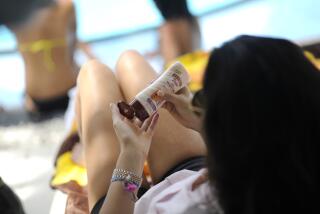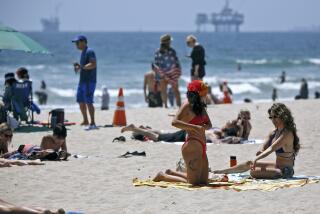Do we have a false sense of protection?
- Share via
On March 30, two law firms filed suits against manufacturers of five leading sunscreen brands. The suits charge that claims on ads and labels promising that products fully protect against harmful rays are misleading and exaggerate the ability of sunscreen to protect against skin damage.
*
-- Janet Cromley
*
The science of skin and sunscreen is all about waves. Ultraviolet (UV) light, a component of sunlight, comes in three forms: UVA, UVB and UVC, each with different wavelength spectrum.
UVC is absorbed in the atmosphere before hitting Earth. UVB exposure is responsible for tanning, sunburning and premature aging of the skin. It’s also linked to the two most common types of skin cancer, basal cell carcinoma and squamous cell carcinoma.
UVA, which penetrates more deeply into the skin, also causes skin aging and has been linked to the rarer and more deadly malignant melanoma, as well as the other skin cancer types. UVA rays are abundant even in the shade.
Most commercially available sunscreens contain chemicals that absorb UVB rays, and their degree of protection is expressed as a sun protection factor (SPF). This, in theory, tells the user how many times longer he can stay in the sun without burning than if he wore no sunscreen. (For example, an SPF of eight means that a person using the product can stay in the sun eight times longer without burning.)
But these SPF values are derived in the laboratory using far more sunscreen than people typically apply -- about one tablespoon for the face or the size of a golf ball for the entire body, says Dr. Sheldon Pinnell, professor emeritus of dermatology at Duke University Medical Center. “Most people will use about one-quarter of that amount,” he says.
Although many products are effective at UVB-blocking, the SPF rating says nothing about UVA protection. Dermatologists worry that high-SPF sunscreens with no UVA protection may encourage sunbathers to stay out too long, exposing themselves to too much UVA.
The best sunscreens provide coverage against UVB, as evidenced by a reasonably high SPF rating (dermatologists recommend at least SPF 15). They also contain UVA-absorbing or UVA-reflecting chemicals such as zinc oxide, avobenzone (Parsol 1789) and titanium dioxide. Pinnell likes zinc oxide because it protects against the broadest spectrum of UVB and UVA rays -- but notes that no sunscreen protects against the entire UVA spectrum.
Apply sunscreen liberally and often because some products degrade when exposed to the sun. And remember that the most effective sunscreen isn’t found in a tube. “The best way to protect yourself is to wear clothes,” Pinnell says. “Any kind of shirt is probably better than any sunscreen.”
More to Read
Sign up for Essential California
The most important California stories and recommendations in your inbox every morning.
You may occasionally receive promotional content from the Los Angeles Times.










